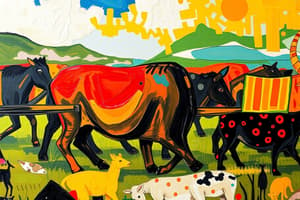Podcast
Questions and Answers
What characterizes exponential growth in a population?
What characterizes exponential growth in a population?
- Population levels off due to limited resources
- Population size increases rapidly without environmental limitations (correct)
- Growth is constant over time
- Growth rate decreases as the population increases
What is meant by the term 'carrying capacity' in an ecological context?
What is meant by the term 'carrying capacity' in an ecological context?
- The initial number of individuals in a population
- The speed at which a population can reproduce
- The amount of food resources available for a population
- The maximum number of individuals an ecosystem can support indefinitely (correct)
Which factor is typically NOT considered a limiting factor in population growth?
Which factor is typically NOT considered a limiting factor in population growth?
- An increase in individual health (correct)
- Weather patterns
- Predation levels
- Availability of food resources
What happens to population growth when it reaches carrying capacity?
What happens to population growth when it reaches carrying capacity?
In logistic growth, what happens during the 'log' phase?
In logistic growth, what happens during the 'log' phase?
Flashcards
Exponential Growth
Exponential Growth
Population growth that increases by a fixed percentage each generation, resulting in a J-shaped curve.
Logistic Growth
Logistic Growth
Population growth that slows as it approaches its carrying capacity, creating a sigmoid (S-shaped) curve.
Carrying Capacity
Carrying Capacity
The maximum population size that a particular environment can sustainably support.
Limiting Factors
Limiting Factors
Signup and view all the flashcards
Study Notes
Population Ecology
- Population sizes are dynamic, meaning populations constantly change – they increase, decrease, or stay stable.
- The size of a population is affected by births, deaths, immigration, and emigration.
- Population ecologists study characteristics like geographic range, density and distribution, growth rate, and age structure.
Population Change
- Populations can increase, decrease, or stay stable. Changes depend on births, deaths, immigration, and emigration.
Studying Populations
- Geographic Range: The area a population inhabits. The range can vary significantly depending on the species; organisms have different sized ranges (e.g., bacteria vs. Atlantic Cod).
- Density and Distribution: The number of individuals per unit area and how they are spread out.
- Different species have different densities in the same area.
- Density can be clumped, uniform, or random.
- Growth Rate: Determines how the population size changes. If the birth rate is higher than the death rate, the population grows; if the death rate is higher than the birth rate, the population shrinks. If they're equal, the growth rate is zero.
- Age Structure: The number of males and females in each age group of the population.
Age Structure
- Researchers use age structure to understand a plant or animal population.
- Most plants and animals reproduce at a specific age once they reach maturity.
Growth Rate
- A positive growth rate means a population's size is increasing.
- A negative growth rate means the size is decreasing.
- A zero growth rate means the population remains stable.
Factors Affecting Growth Rate
- Birth Rate: The number of births per unit of time.
- Death Rate: The number of deaths per unit of time.
- Immigration: Individuals moving into a population.
- Emigration: Individuals moving out of a population.
Immigration and Emigration
- Immigration: Causes a population to grow, because organisms are entering the population.
- Emigration: Causes a population to shrink, because organisms are leaving the population.
Reproductive Rates
- The rate of exponential growth varies among different organisms.
- Organisms reproduce at differing rates, based on biology or environment factors.
- Organisms have different gestational periods; this affects the rate of population change. An example is given of rats growing exponentially due to short gestation. Given two rats, under ideal conditions they can grow to 1250 in a year.
Exponential and Logistic Growth
- Exponential Growth: A population grows faster and faster as time goes on. This occurs when there are unlimited resources. Graphing creates a J-shaped curve.
- Logistic Growth: Exponential growth slows down and eventually stops as the population reaches carrying capacity. This occurs when resources become limited. Following exponential growth, the curve creates an S-shaped graph.
Population Growth
- If a population has unlimited resources, the population will grow exponentially.
- Factors such as food supply, space, disease, and predators cause growth to eventually limit.
- What happens when a population has all its needs met, like unlimited resources, protection from predators, and access to space? In these perfect conditions, will it grow, shrink, or remain the same?
Carrying Capacity
- Carrying capacity is the maximum number of individuals of a species that an environment can support.
- When growth stops, the population reaches carrying capacity, meaning it levels off and thus is stable.
- The environment cannot sustain any more individuals.
Limiting Factors
- These determine carrying capacity and control population growth.
- Examples include resources, space, climate, and other factors.
- Limiting factors can act separately or together to limit carrying capacity. They limit how large a population can grow.
- Limiting factors control populations, keeping them between overpopulation and extinction.
- Over time, limiting factors lead to natural selection and evolution.
Density Dependent Limiting Factors
- These factors depend on the density (number per unit area) of a population.
- Examples include competition, predation, herbivory, parasitism, disease, stress from overcrowding.
Density Independent Limiting Factors
- These factors do not depend on the density of a population.
- Examples include natural events like hurricanes, droughts, floods, or wildfires.
- Human influence such as pesticide use also play a role.
Logistic Growth
- Most populations do not grow exponentially forever.
- Eventually they will reach a point that is controlled by growth limitations such as carrying capacity.
- Factors like birth rate, death rate, immigration and emigration, space, resources, and disease all influence Logistic Growth, and may cause exponential growth to slow, stop and eventually stabilize.
Phases of Logistic Growth
Logistic growth occurs in three phases:
- Phase 1: Exponential Growth – resources are unlimited. Death rate is low, birth rate is high
- Phase 2: Growth Slows – Population still grows but slows down.
- Phase 3: Growth Stops – The population reaches its carrying capacity. Birth rate and death rate are equal.
Types of Limiting Factors
- Limiting factors can be density-dependent or density-independent.
- Density-dependent factors (competition, disease, predation, etc.) change with population density.
- Density-independent factors (weather, natural disaster, etc.) affect populations regardless of density.
Competition
- Competition is a density-dependent limiting factor; it increases with population density.
- Individuals compete for resources such as food, water, territory, sunlight, and mates.
Predator and Prey
- Populations of predators and prey cycle over time.
- For example, when moose populations increase, wolves have more to eat, which causes wolf populations to grow. This, in turn, causes a decrease in the moose population as wolves eat more moose. The cycle continues over time as predator populations and prey populations fluctuate.
Herbivory
- Herbivores (animals that eat plants) act as predators from a plant's perspective.
- Plant and herbivore populations cycle like predator-prey relationships: When herbivore populations increase they eat more plants causing plant populations to decrease, which then causes herbivore populations to decrease.
Parasitism and Disease
- Parasites and disease-causing organisms weaken or kill their hosts. This helps maintain population control by reducing population size.
Overpopulation
- High population densities lead to overcrowding and stress, which can affect birth rates, death rates and migration.
Studying That Suits You
Use AI to generate personalized quizzes and flashcards to suit your learning preferences.




